Make plans to join sea turtle researchers, academics, volunteers, and conservationists traveling from Virginia to Texas to attend the 4th Southeast Regional Sea Turtle Meeting!
Meeting in a snapshot . . .
Two Keynote Speakers kick off two full session days featuring special sessions on Changing Climate, Sustainable Beaches, and Science that Supports Conservation and Recovery.
David Helvarg, Executive Director of Blue Frontier, is an award-winning journalist and passionate advocate for ocean conservation as well as the author of six books. David has worked as a war correspondent in Northern Ireland and Central America, covered a range of issues from military science to the AIDS epidemic and reported from every continent including Antarctica.
Nicole Hernandez Hammer, climate science and community advocate at the Union of Concerned Scientists, previously served UCS as a climate outreach consultant and was invited by Michelle Obama to the 2015 State of the Union address. Nicole has given numerous interviews for local and national media, and made an appearance in National Geographic’s television series on climate change: Years of Living Dangerously.
Workshops
Fancy building, programming and flying an unmanned aerial drone for wildlife conservation research?
How about a closer look at the causes of sea turtle strandings and the latest developments in sea turtle rehabilitation?
Ready to explore a career in the world of sea turtle conservation or learn about political advocacy in advancing sea turtle conservation?
What about addressing the common themes and issues of volunteer groups and the vital role they play in conservation?
SERSTM Exhibitors/Vendors will be set up and ready to sell, share, and educate. The Silent Auction will be in full swing with unique items waiting for your bids. Feel free to donate, bid, and peruse to your hearts content.
The Southeast Regional Sea Turtle Meeting is offering a very special workshop for the first time ever available to the public only. Turtle Ambassadors: How Citizens Can Aid in Sea Turtle Conservation promises to be enlightening and connect the local community with representatives from several organizations skilled in teaching how to be an active participant in sea turtle conservation. Click here to download the flyer! Click here to download the flyer!
You can do all this, and more, at the 2018 Southeast Regional Sea Turtle Meeting. Check out the links below and we’ll see you in Myrtle Beach!
www.serstm.org https://www.facebook.com/SoutheastRegionalSeaTurtleMeeting
Abstract Submission: http://www.serstm.org/abstracts-posters/
Accommodation: http://www.serstm.org/home/accommodations/
Exhibitors/Vendors: http://www.serstm.org/home/vendor/
Registration: http://www.serstm.org/home/registration-2/
Workshops: http://www.serstm.org/home/workshops/
Mission Statement: In order to advance marine turtle knowledge and conservation efforts from Virginia to Texas, the Southeast Regional Sea Turtle Meeting facilitates the presentation and exchange of scientific research from diverse disciplines conducted on the beaches and waters of the southeastern United States.
 On May 2, 2012, Lisa Jo Randgaard passed away suddenly from a rare and chronic congenital heart condition. She was 43 years old. Heartbroken when their youngest child died, the family turned to fundraising for endangered sea turtles to channel grief into positive action. Lisa was dedicated to the cause, in part through the education she received from Sea Turtle Conservancy; she admired the animals’ great strength, yet related personally to their vulnerability. The family honored her passion and established The Lisa Jo Randgaard Fund, STC’s first member-initiated endowment fund. They were committed to make donations of their own and to cover all costs of their fundraising projects to ensure that 100% of ALL MONEY RAISED goes to Lisa’s Fund.
On May 2, 2012, Lisa Jo Randgaard passed away suddenly from a rare and chronic congenital heart condition. She was 43 years old. Heartbroken when their youngest child died, the family turned to fundraising for endangered sea turtles to channel grief into positive action. Lisa was dedicated to the cause, in part through the education she received from Sea Turtle Conservancy; she admired the animals’ great strength, yet related personally to their vulnerability. The family honored her passion and established The Lisa Jo Randgaard Fund, STC’s first member-initiated endowment fund. They were committed to make donations of their own and to cover all costs of their fundraising projects to ensure that 100% of ALL MONEY RAISED goes to Lisa’s Fund.
Jenny, Diane, and Linda – Lisa’s Mom and two older sisters – began by hand sewing “Lisa’s Fundanas,” raising over $10,000, shipping 334 of these sea turtle bandanas across the country, and to Puerto Rico, Canada and Europe! The overwhelming support led Diane to learn cold-process soapmaking, and the family launched “Flippery When Wet” natural soap bars, with pure essential oils. Available only on their website, LoveIntoSustainedAction.com, over 1,000 bars have shipped, to date. In addition to Lisa’s unrestricted endowment fund, the family directed personal funds to dedicate in July 2016 the eco-friendly Lisa Jo Randgaard Building for staff housing and offices at STC’s research site in Tortuguero, Costa Rica. In four years, the Randgaards have raised $90,000, with a renewed commitment moving forward.
 In October 2016, Jenny passed away, and the torch is now in the hands of Linda and Diane. They have created an online Pop-Up Vintage Jewelry Fundraiser that runs until Sept. 4. As Linda explains, “These special pieces belong to our family and this is another way to ensure that Lisa’s legacy shines bright. We know Mom approves, and we remain forever ‘Three Sisters United’ in our quest to protect endangered sea turtles.”
In October 2016, Jenny passed away, and the torch is now in the hands of Linda and Diane. They have created an online Pop-Up Vintage Jewelry Fundraiser that runs until Sept. 4. As Linda explains, “These special pieces belong to our family and this is another way to ensure that Lisa’s legacy shines bright. We know Mom approves, and we remain forever ‘Three Sisters United’ in our quest to protect endangered sea turtles.”
Visit LoveIntoSustainedAction.com to view jewelry.
The Sea Turtle Grants Program (STGP), funded by the sale of Florida’s Helping Sea Turtles Survive specialty license plate, recently awarded $362,564.95 to 29 different projects benefiting Florida sea turtles as part of the 2017-2018 grant funding cycle.

Each year, the Sea Turtle Grants Program distributes money to coastal county governments, educational and research institutions and nonprofit groups through a competitive application process. The sea turtle specialty license plate is also the primary source of funding for the Florida Fish and Wildlife Conservation Commission’s Marine Turtle Protection Program.
The following organizations received grants for their approved projects for the 2017-2018 cycle:
The sea turtle plate is the number two overall selling specialty tag in Florida, and the number one environmental specialty plate. By purchasing the sea turtle specialty license plate, Floridians are voluntarily funding important programs to save endangered sea turtles and their habitats.
To learn more about the Sea Turtle Grants Program and the “Helping Sea Turtles Survive” specialty license plate, please visit www.helpingseaturtles.org.
Are you planning to upgrade your phone and don’t know what to do with your old one? Or maybe you have a drawer full of old cell phones and electronics collecting dust? Great news… You can recycle your old devices and raise money for sea turtles at the same time with SecondWave Recycling!
 SecondWave Recycling partners with non-profits to fundraise by recycling cell phones, tablets and iPods! SecondWave will donate 100% of the wholesale value of the device to STC. This program also keeps phones out of landfills, which prevents harmful toxins from potentially seeping into waterways. The materials that go into these devices also have more than just one life and can be used for new technology!
SecondWave Recycling partners with non-profits to fundraise by recycling cell phones, tablets and iPods! SecondWave will donate 100% of the wholesale value of the device to STC. This program also keeps phones out of landfills, which prevents harmful toxins from potentially seeping into waterways. The materials that go into these devices also have more than just one life and can be used for new technology!
Since partnering with SecondWave in 2014, STC supporters have helped recycle over 800 phones and earned $1,035 in donations for sea turtles!
 Sending in your phone is quick, easy, and FREE if you send in 4 or more phones at once! To donate your cell phone, all you have to do is visit www.secondwaverecycling.com/, click Donate Your Phone, choose Sea Turtle Conservancy as your Charity and print out your mailing label. Or if you are planning to send in multiple devices, you can click here to get a FREE FedEx shipping label!
Sending in your phone is quick, easy, and FREE if you send in 4 or more phones at once! To donate your cell phone, all you have to do is visit www.secondwaverecycling.com/, click Donate Your Phone, choose Sea Turtle Conservancy as your Charity and print out your mailing label. Or if you are planning to send in multiple devices, you can click here to get a FREE FedEx shipping label!
**NOTE – Free shipping labels can only be provided for US-based shipments. For international shipments, please use your local postal carrier and ship to the SecondWave Recycling Office.**
Besides helping sea turtles, here are a few other reasons why you should donate your old phone:
 The mining of metals for cell phones and other electronics is the #1 cause of toxic pollution in the United States.
The mining of metals for cell phones and other electronics is the #1 cause of toxic pollution in the United States.
One million cell phones contain 33 pounds of palladium, 75 pounds of gold, 772 pounds of silver and 35,274 pounds of copper. These resources can be recovered and used to make new cell phones.

Cell phones contain toxic materials such as Arsenic, Antimony, Beryllium, Cadmium, Copper, Lead, Nickel and Zinc. If these materials are not properly disposed of they can contaminate air, soil and groundwater. The Cadmium from a single cell phone is capable of polluting 158,200 gallons of water.

If we recycled every cell phone discarded in the United States annually we would save enough energy to power more than 24,000 homes for a year. Recycling just one cell phone saves enough energy to power a laptop for 44 hours!
Questions about our SecondWave Recycling campaign? Email lexie@conserveturtles.org
The race has officially ended with high spirits and exhausted flippers! We want to extend a huge congratulations to our winner Lady Aurelia, who swam further than any other competitor in Tour de Turtles history! While she powered herself the 3,465 miles to victory, she was never alone as she had her amazing sponsors at the New England Cord Blood Bank (NECBB) by her side. Interestingly, NECBB chose the “outside the box” name, Lady Aurelia, to reflect their sponsorship, which does not quite “fit the norm” as they put it themselves. Indeed, without any direct ties to marine/tourism industry, NECBB was a unique sponsorship! CEO Joe Rizza said he hopes that their involvement in the Tour de Turtles will “encourage other companies and individuals to consider being a sponsor.” Sea Turtle Conservancy is extremely grateful for NECBB’s involvement and could not have agreed with them more when they said, “It was a great way to raise much needed funds and awareness for the excellent work the Conservancy does every day, for sea turtle conservation.”
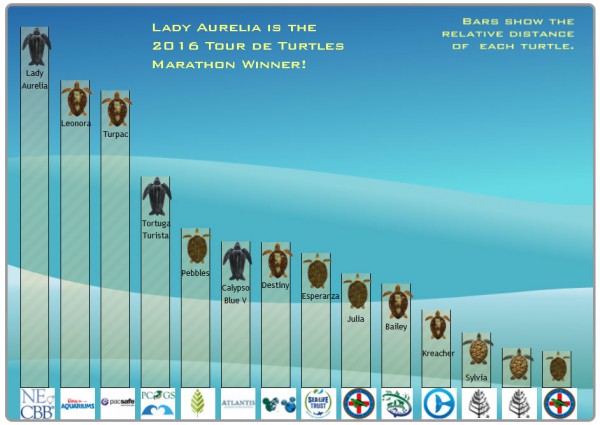
Tour de Turtles 2016 Race Results
1. Lady Aurelia = 3465 miles
2. Leonara = 2080 miles
3. Turpac = 1531 miles
4. Tortuga turista = miles
5. Pebbles = 1089 miles
6. Calypso Blue V = 1017 miles
7. Destiny = 1020 miles
8. Esperanza = 918 miles
9. Julia = 807 miles
10. Bailey = 716 miles
11. Kreacher = 557 miles
12. Sylvia = 303 miles
13. Sundrop = 163 miles
14. Fleming = 124 miles
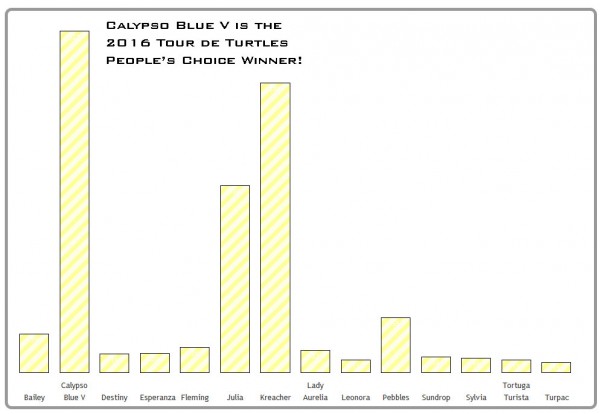 Although Lady Aurelia won in miles, we have another TDT competitor who won our hearts. And so, we are happy to announce Calypso Blue V as our 2016 People’s Choice Winner! Without the countless fans who donated and voiced their support, his victory and the tremendous progress of the other competing turtles, would not be possible. Sea Turtle Conservancy is so thankful for your support! Of course, behind every competitor is an organization that made their participation possible. Thank you to those at Atlantis for your involvement in Tour de Turtles! “Atlantis, Paradise Island is very proud to have worked with the Sea Turtle Conservancy over the last five years on Tour de Turtles” said Debra Erickson, Executive Director of the Atlantis Blue Project Foundation. “With all of the challenges that sea turtles face, Tour de Turtles provides a much-needed opportunity for school children and the public to learn more about sea turtles and how they can help save them.We are thrilled that we were able to share the adventures of Calypso Blue V with all of our supporters and that she won the People’s Choice Award.”
Although Lady Aurelia won in miles, we have another TDT competitor who won our hearts. And so, we are happy to announce Calypso Blue V as our 2016 People’s Choice Winner! Without the countless fans who donated and voiced their support, his victory and the tremendous progress of the other competing turtles, would not be possible. Sea Turtle Conservancy is so thankful for your support! Of course, behind every competitor is an organization that made their participation possible. Thank you to those at Atlantis for your involvement in Tour de Turtles! “Atlantis, Paradise Island is very proud to have worked with the Sea Turtle Conservancy over the last five years on Tour de Turtles” said Debra Erickson, Executive Director of the Atlantis Blue Project Foundation. “With all of the challenges that sea turtles face, Tour de Turtles provides a much-needed opportunity for school children and the public to learn more about sea turtles and how they can help save them.We are thrilled that we were able to share the adventures of Calypso Blue V with all of our supporters and that she won the People’s Choice Award.”
So, with an end to Tour de Turtles 2016, we want to express our gratitude once again for all the sponsors and individuals who supported the race and further, those who continually support our efforts! Sea turtle conservation is such an important cause for our world and your support does not go unnoticed.
Tour de Turtles 2016 Sponsors
| Atlantis, Paradise Island | Cuba Marine Research and Conservation Program | pacsafe |
|
Clearwater Marine Aquarium |
DivinityLA |
Ripley’s Aquariums |
|
Disney’s Animal Programs |
Four Seasons Resort Nevis |
Sea Life Trust |
|
Disney’s Vero Beach Resort |
New England Cord Blood Bank |
Shark Reef Aquarium |
|
Disney’s Conservation Fund |
Patel College of Global Sustainability |
The Turtle Hospital |
See you next year for Tour de Turtles 2017!
Sea Turtle Conservancy (STC) would like to give a special congratulations to the winners of our 2017 Sea Turtle Scenes Calendar Contest! All of the photos were truly fantastic. Thank you to everyone who took the time to enter!
The winning photographs will be featured in STC’s 2017 Sea Turtle Scenes Calendar, which will be available online in our gift shop sometime in November. Thank you to all of our participants who made this year’s selection exciting and especially difficult. We received HUNDREDS of submissions! If you missed out on this one, look out for the 2018 photography contest next year!
Here are this year’s winners:
By: Colin Davis **Cover Image!**

By: Joanie Tomlin
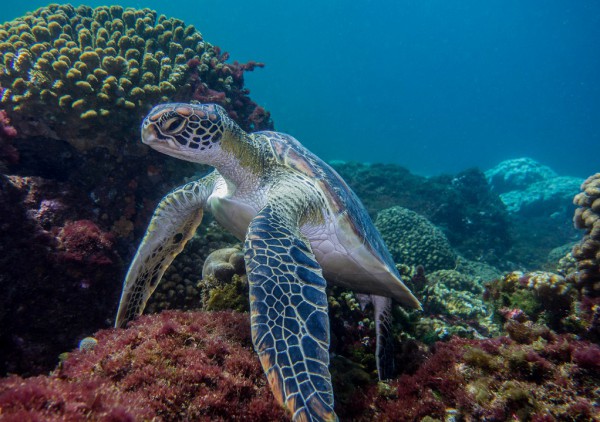
By: Karla Morales

By: Ralph Pace
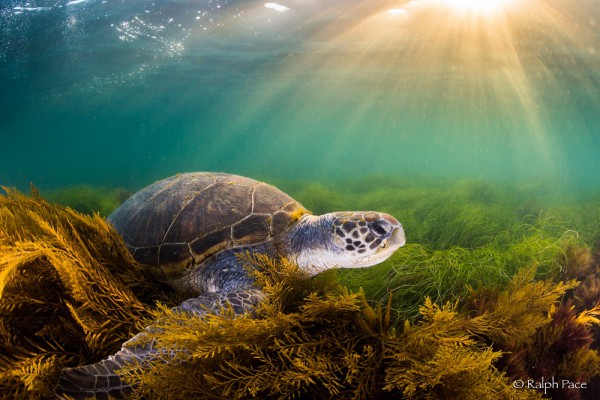
By: Spencer Sarson
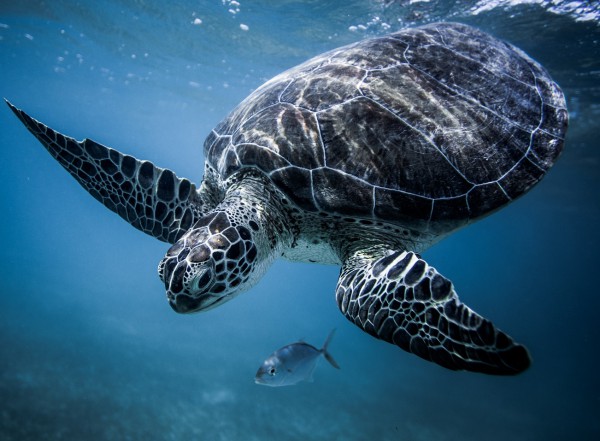
By: Staci-Lee Sherwood

By: Mario Cisneros
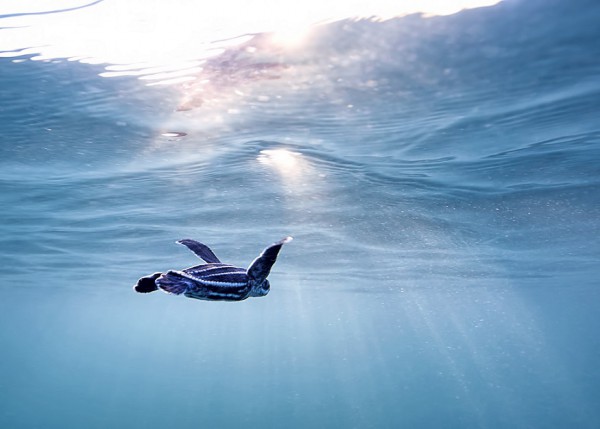
By: Colin Davis

By: Ursula Dubrick

By: Ben Hicks

By: Celeste McWilliams

By: Karla G. Barrientos-Munoz
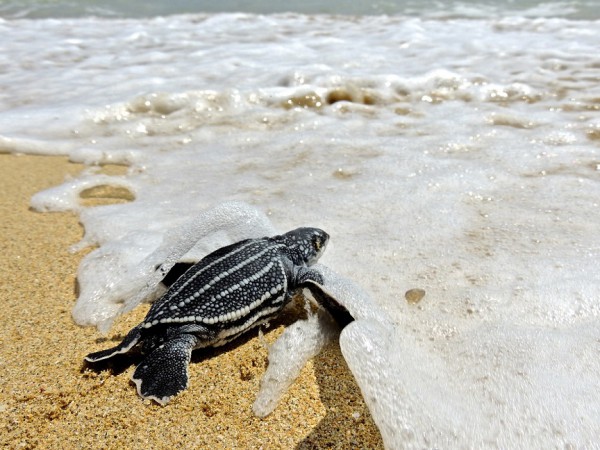
By: Mario Cisneros

By: Staci-Lee Sherwood

 Sea Turtle Conservancy (STC) is excited to officially welcome our partners at DivinityLA to the Tour de Turtles marathon! For this year’s Tour de Turtles, DivinityLA sponsored a green turtle, who they named “Pebbles.” When deciding on a name for their turtle, DivinityLA was inspired by the importance of pebbles and sand in the turtles’ nesting and hatching process.
Sea Turtle Conservancy (STC) is excited to officially welcome our partners at DivinityLA to the Tour de Turtles marathon! For this year’s Tour de Turtles, DivinityLA sponsored a green turtle, who they named “Pebbles.” When deciding on a name for their turtle, DivinityLA was inspired by the importance of pebbles and sand in the turtles’ nesting and hatching process.
To begin her migration marathon, Pebbles, a green turtle from Tortuguero, Costa Rica, was released on July 9, 2016 from STC’s John H. Phipps Biological Field Station in Tortuguero.
Since the launch of their company in 2015, DivinityLA has donated over $17,000 to Sea Turtle Conservancy- a tremendous effort that should not go unrecognized! One dollar from every sea turtle bracelet purchased is donated to STC. Click here to purchase and support sea turtles!

Pebbles is released with a satellite transmitter in Tortuguero
In addition to the incredible partnership they have with STC, DivinityLA has developed partnerships with a number of other hand-selected non-profits whose purpose supports their own mission and values. With each bracelet purchased, a portion of the proceeds is donated to one of the organizations. As DivinityLA representative Kailey Ruiz said, “In our world, we need more companies who are willing to look out for the greater good, as well as their own, and by contributing to wildlife conservation and human improvement we are playing our part as best we can.”
While they have greatly involved themselves in making a global impact through donations to  international DivinityLA turtle bracelet NEWorganizations like STC, DivinityLA also focuses on making improvements closer to home. Through meal preparation and distribution for the homeless, DivinityLA gives back to their local Los Angeles community. “We believe that any and all efforts, big or small, can have a lasting impact on all living things that surround us.”
international DivinityLA turtle bracelet NEWorganizations like STC, DivinityLA also focuses on making improvements closer to home. Through meal preparation and distribution for the homeless, DivinityLA gives back to their local Los Angeles community. “We believe that any and all efforts, big or small, can have a lasting impact on all living things that surround us.”
For DivinityLA, Tour de Turtles is the next step in expressing their loyalty to and support of sea turtle conservation. “We are very excited about the opportunity to follow these turtles on such an intimate and remarkable journey. We can’t wait to see their movement throughout the migration and anticipate the nesting of their future hatchlings!”
$1 from every sea turtle bracelet purchased is donated to STC. Click here to purchase and support sea turtles! And don’t forget to follow Pebbles on her marathon migration! You can view her satellite map online here.

This year in our race to spread awareness, Tour De Turtles has 3 BIG competitors joining us all the way from Panama. Adult leatherbacks Calypso Blue V, Lady Aurelia, and Tortuga Turista join the race to shed some light on various issues affecting the sea turtle population.
First we have Calypso Blue V who is swimming to raise awareness about the detrimental effects of commercial trawl fishing on sea turtles. More than 250,000 sea turtles are accidentally captured, harmed, or killed by fishermen in the U.S. alone each year. Trawling, which involves large nets being dragged behind one or more boats, poses such a serious threat due to its capacity to blindly catch all marine life in its path. While migrating through fishing areas, or feeding within those areas, sea turtles run the tremendous risk of being tangled within trawl nets, leading to possible injury or death. The implementation of Turtle Excluder Devices (TEDs) can reduce turtle captures by 90%, but are not currently required in non-shrimp trawl fisheries. With the incredible help from Atlantis, Paradise Island, we hope to expand the use of TEDs in all trawl fisheries and further regulate the industry.
 Our next turtle, Lady Aurelia, is sponsored by the New England Cord Blood Bank to bring attention to the issues caused by invasive species. While sea turtles have many natural predators that help regulate the natural balance of the food chain, human development has brought rise to several unnatural predators that further endanger sea turtle populations. Trash left on the beach by humans attracts raccoons, stray dogs, or other non-native species in search for food; in turn, these animals may encounter a sea turtle nest or hatchlings and decide it a sufficient food source. Raccoons destroy tens of thousands of sea turtle eggs and hatchlings a year, making it one of the greatest causes of sea turtle mortality on Florida beaches. In Central America, dogs pose the greatest threat as many coastal villages allow them to run free where they can dig up several nests in one night, or even attack a nesting turtle. This problem can be solved with just some small steps us humans!
Our next turtle, Lady Aurelia, is sponsored by the New England Cord Blood Bank to bring attention to the issues caused by invasive species. While sea turtles have many natural predators that help regulate the natural balance of the food chain, human development has brought rise to several unnatural predators that further endanger sea turtle populations. Trash left on the beach by humans attracts raccoons, stray dogs, or other non-native species in search for food; in turn, these animals may encounter a sea turtle nest or hatchlings and decide it a sufficient food source. Raccoons destroy tens of thousands of sea turtle eggs and hatchlings a year, making it one of the greatest causes of sea turtle mortality on Florida beaches. In Central America, dogs pose the greatest threat as many coastal villages allow them to run free where they can dig up several nests in one night, or even attack a nesting turtle. This problem can be solved with just some small steps us humans!
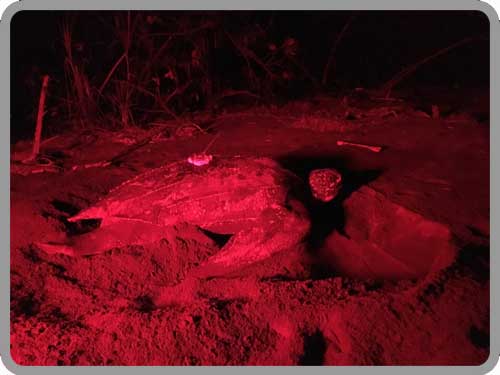 Tortuga Turista is our last leatherback sea turtle from Panama. She, along with the tremendous support from her sponsors at the USF Patel College of Global Sustainability, is joining the race to speak up about sustainable tourism. Tourism is an ever-growing industry in our increasingly globalized world. While it brings forth countless economic and social benefits, it does not come without its many environmental concerns. Of greatest concern to us, is the impact of coastal tourism on this fragile ecosystem and its multitude of wildlife, like sea turtles. Nesting habitat degradation, an increase in waste, rise in boat strikes, and an increase in illumination on beaches—which discourage possible nesting turtles— are only some of the negative impacts seen with a rise in tourism. Through education and proper planning and management, the impact can be greatly reduced.
Tortuga Turista is our last leatherback sea turtle from Panama. She, along with the tremendous support from her sponsors at the USF Patel College of Global Sustainability, is joining the race to speak up about sustainable tourism. Tourism is an ever-growing industry in our increasingly globalized world. While it brings forth countless economic and social benefits, it does not come without its many environmental concerns. Of greatest concern to us, is the impact of coastal tourism on this fragile ecosystem and its multitude of wildlife, like sea turtles. Nesting habitat degradation, an increase in waste, rise in boat strikes, and an increase in illumination on beaches—which discourage possible nesting turtles— are only some of the negative impacts seen with a rise in tourism. Through education and proper planning and management, the impact can be greatly reduced.
Join us in supporting one of these amazing turtles and their important cause! Visit www.tourdeturtles.org today to cheer for your favorite turtle!
Sea Turtle Conservancy is proud to announce the release of a new documentary about sea level rise and its implications for sea turtles and their nesting beaches in Florida. “Ahead of the Tide” (AOTT) was co-produced by STC and CAVU, a non-profit that uses flight and film to educate people about critical conservation issues. AOTT highlights the effects of sea level rise and climate change on Florida’s beaches through the stories and voices of local Floridians. The video includes interviews with scientists, coastal engineers, elected officials, coastal planners, conservation leaders, authors and activists. As part of this project STC, CAVU, and a host of conservation partners will be sponsoring a series of webinars on climate change and sea level rise in the coming months. You can learn about and sign up for these webinars at Aheadofthetide.org.
Sea level rise will have serious and long term impacts to the state’s sea turtle nesting beaches. Our hope is that this powerful film will help to serve as a Call to Action for all Floridians to demand that our elected leaders, government agencies and coastal communities begin planning for sea level rise in order to protect Florida’s most valuable asset — its natural sandy beaches — both for sea turtles and for people. The state’s beaches belong to all Floridians; they define our state.
Sea Turtle Conservancy believes many specific actions can be taken and policies implemented to reduce the impacts of sea level rise and climate change on sea turtle nesting beaches while also helping to protect our beaches and to ensure coastal resiliency. Most importantly, we have to start making smarter decisions about how we manage our beaches and where we build along the coast – and where we rebuild as the seas continue to rise. Of the hundreds of pages that make up Florida’s coastal development and beach management laws there is virtually no mention of sea level rise, despite the fact that Florida’s beaches are among the most vulnerable in the nation to changes in sea level. Many of Florida’s elected leaders still deny the realities of climate change and resist any effort to plan for its impacts. We hope this video will help raise awareness and empower citizens to demand that our elected officials take action.
Earlier this month, Sea Turtle Conservancy (STC) was contacted by turtle colleagues in Mexico who had spotted a green turtle with a satellite transmitter on her back nesting in Quintana Roo, Mexico. It was our Esperanza from Cuba! After receiving photos from Mexico, STC was able to identify Esperanza by her flipper tag number (which is unique to only her) and her satellite transmitter.

Esperanza nesting in Mexico
This discovery is very important because it helps confirm a pattern our partners with the Cuban Marine Turtle Conservation Program have been observing recently based on flipper tags and genetics. It was the same area where they had seen several previous nesters from Cuba go.
But wait…
What are sea turtles that nested in CUBA doing nesting in MEXICO?? This is very unusual, and it suggests that sea turtles may not be as loyal to one beach as we thought! Most females return faithfully to the same beach each time they are ready to nest. Not only do they appear on the same beach, they often emerge within a few hundred yards of where they last nested!
One of the benefits of using satellite transmitters to track sea turtles is that it helps us determine turtles’ nesting site fidelity. Or in this case, lack of fidelity.
We will continue to watch Esperanza closely over these next few months and so can you! As part of the Tour de Turtles program, you can visit Esperanza’s tracking map to see where she travels next! /trackingmap.php?id=144
Esperanza is a beautiful adult green sea turtle who was released with a satellite transmitter after nesting in Guanahacabibes Natural Park, Cuba on June 29, 2016. This turtle mama laid 152 eggs! She measured 107 cm in curved carapace (shell) length and 93 cm in curved carapace width. Esperanza, which means “hope in Spanish,” was named by her sponsors at SEA LIFE Trust and is participating in the 2016 Tour de Turtles migration marathon.

Screenshot of Esperanza’s tracking map.
To learn more about Esperanza and the rest of our Tour de Turtles competitors, visit www.TourdeTurtles.org
Kashmir World Foundation (KwF), in collaboration with Sea Turtle Conservancy and Brevard County, Florida, will be conducting a 3-day hands-on workshop on the design, fabrication and operation of programmable multi-copters for use in environmental monitoring. The workshop will assist you in creating a basic platform to evaluate a variety of unmanned aerial systems (UAS) for diverse habitats and environments while providing the expertise you need to build, maintain, and fly your drone.
http://www.kashmirworldfoundation.org/#!bic/cslv
To download event flyer: FlyForConservation

![]()

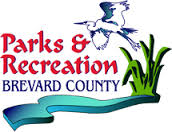
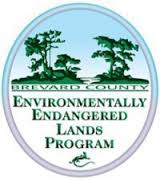
Sea Turtle Conservancy (STC) announces a change in the scientific oversight of its international sea turtle research and monitoring programs. Effective in July, the position of Scientific Director will transition from Dr. Emma Harrison to Dr. Roldán Valverde. Anyone interested in collaborating with STC on research projects in Costa Rica, Panama and other international sites are encouraged to reach out directly to Dr. Valverde at roldan@conserveturtles.org. Likewise, anyone interested in exploring opportunities to serve as a Research Assistant with the Tortuguero program or at STC’s project sites in Panama can now direct those inquires to Roldán.

Dr. Harrison with nesting turtle
While STC is very excited about what Dr. Valverde will bring to this position, the organization is equally sad to announce the departure of Dr. Emma Harrison, who has resigned to explore new opportunities in the field of biological conservation. Dr. Harrison has worked with STC off and on since 1998 and has served as Scientific Director since 2006. Through her leadership and passion, Dr. Harrison continued a long tradition of outstanding scientific oversight of STC’s sea turtle monitoring programs; she trained and inspired countless research assistants and helped expand STC’s education and community outreach programs in both Costa Rica and Panama. Emma will be greatly missed by STC, though she will forever remain a part of the STC family and the history of the organization.
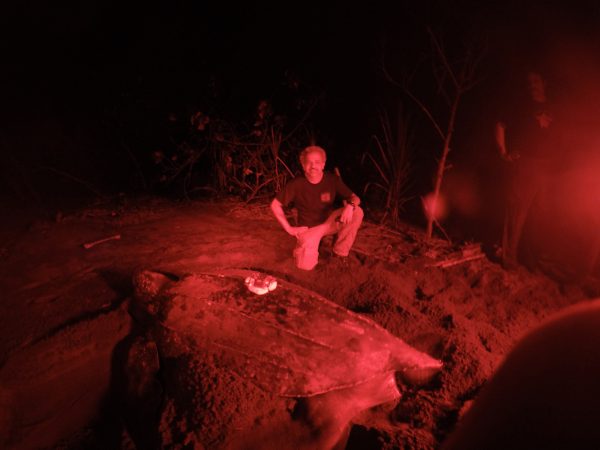
New STC scientific director Dr. Valverde with tagged leatherback
As STC’s incoming Scientific Director, Dr. Valverde will provide scientific oversight of STC’s various sea turtle research programs, particularly the long-term projects in Tortuguero, Costa Rica, and Bocas del Toro, Panama. Over two decades ago, as a young Costa Rican biologist, Roldán served as Research Coordinator of STC’s Tortuguero research program. Since that time, he has achieved international recognition in the field of sea turtle research and is a leading expert in the area of sea turtle physiology. Dr. Valverde served recently as President of the International Sea Turtle Society; he is well published; and he currently serves as a graduate biology professor at Southeast Louisiana University in New Orleans. As a native Costa Rican and an accomplished scientist and educator, Roldán will be in an ideal position to continue elevating the science and the effectiveness of STC’s many research and conservation programs. He also will help STC expand its efforts to cultivate and train young biologists from throughout Latin America and the Caribbean. Dr. Valverde’s position with STC is endowed by the Emily T. Clay Scientific Director’s Endowment.
The 11th annual Endangered Species Day is May 20th, 2016! Endangered Species Day was created by Congress in an effort to raise awareness of the many endangered, threatened, and at risk species and the critical role they play in their environments.
Many zoos, parks, wildlife refuges, museums, schools and community centers, among other participants, will host educational events to promote and celebrate Endangered Species Day and the reasons behind its creation. To find an event near you, visit http://www.endangered.org/campaigns/endangered-species-day/

Endangered Species Day raises awareness about the many endangered species we have in our own communities. For example, did you know Florida has more endangered species than any other Atlantic state? Population growth coupled with habitat loss, tourism, and pollution are just a few factors that have imperiled many species in our state. In addition, Endangered Species Day is also a great time to celebrate success stories, like the recovery of the green turtle, the alligator, and the bald eagle.Thanks to the significant strides we have made under the Endangered Species Act, we are celebrating more and more success stories with each passing year.
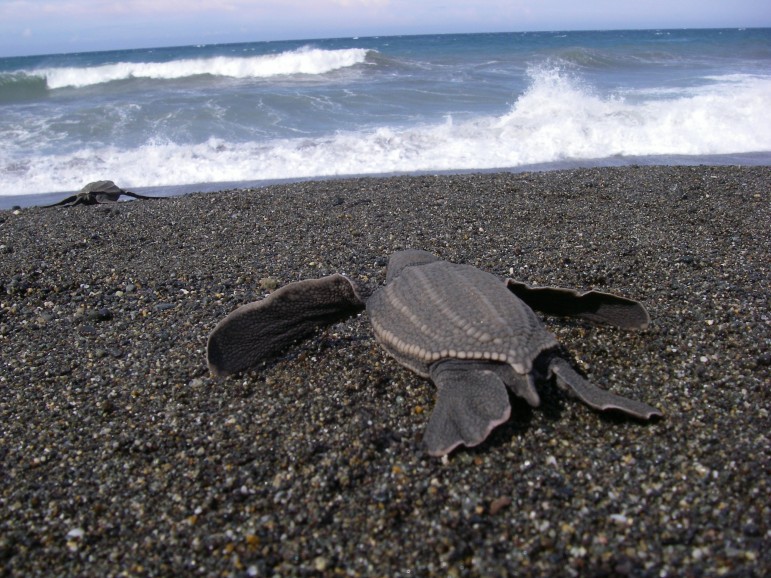
Photo retrieved from Endangered Species Coalition
For decades all sea turtles in U.S. waters have been listed under the Endangered Species Act, which was created in 1973.They are protected by the NOAA Fisheries in the ocean and by the U.S. Fish and Wildlife Service (USFWS) in their beach nesting habitats along U.S. coasts. In the United States threats to sea turtles include habitat loss, pollution and disease, boat strikes, entanglement in marine debris and accidental capture in fisheries. However, unlike other species of sea turtles, green turtles interact less with fisheries, which has contributed significantly to their recovery and made them an Endangered Species Act success story. During the nesting season of 1990, fewer than 50 green sea turtles were documented at the Archie Carr National Wildlife Refuge on Florida’s east coast. By 2005, there were just over 3,000 nests. In the most recent nesting season of 2015, green sea turtles set a new record with 14,152 nests! This comeback makes green turtles one of the greatest conservation success stories of our time. The species’ success can be attributed to the Endangered Species Act, STC and all other supporters who worked tirelessly to give green turtles a fighting chance.

Green Sea Turtle by Julie Suess
Sea turtles are not the only species that have had huge success stories thanks to the Endangered Species Act. Many species you may encounter on a regular basis in Florida were once on the brink of extinction. In the 1950s, the American alligator had nearly been hunted to extinction, but thanks to habitat protections and strong hunting regulations, their population from North Carolina to Texas has increased to about 5 million. The brown pelican was dramatically impacted by loss of habitat, but under the Endangered Species Act, they have made a strong comeback, and were officially removed from the endangered species list in 2009. Our national bird, the bald eagle, numbered in the hundreds in the 1960s, but with protection and the elimination of the pesticide DDT, which made eggs to fragile to hatch, its numbers have soared to over 14,000 breeding pairs today. The Endangered Species Act protects 1,357 species of animals (694 U.S. species) and 901 species of plants (898 U.S. species), and has prevented their extinction, which in turn helps to maintain healthy and sustainable ecosystems and a healthy planet.
On Endangered Species Day celebrate the Act’s successes and keep the momentum going!
1. Learn about endangered species
The best way to protect endangered species is learning about them and why they’re important. So teach yourself and educate those around you about the value of endangered species and why they are worth saving in their own right. STC’s educational program empowers sea turtle groups throughout Florida, provides educational materials and uses the concept of sea turtle migration tracking as an online educational tool. Learn more about endangered species by visiting the official site of the US Fish and Wildlife Service at www.fws.gov/endangered
 2. Visit a national wildlife refuge, park or other open space
2. Visit a national wildlife refuge, park or other open space
These places are home to a lot of different species, and preserving an endangered species’ habitat is essential to protecting the species. You can help by visiting a refuge close to where you live and become a volunteer. The Archie Carr National Wildlife Refuge in Florida is a major safe haven for sea turtles. About 25 % of Florida’s sea turtle nesting occurs in the Refuge.
3. Make your home wildlife friendly
Secure garbage in shelters or cans with locking lids and feed pets indoors to avoid attracting wild animals to your home. Taking these actions can keep animals like raccoons, which are sea turtle predators, away. Reduce your use of water in your home and garden so animals that live in or near water can have a better chance of survival. If you live on the beach you can make your home sea turtle friendly by implementing sea turtle lighting.
4. Plant native plants
Native plants provide food and shelter for native animals. You can plant sea oats on the beach to help prevent dune erosion and provide habitat for sea turtle nesting. STC conducts native dune vegetation planting to provide an additional buffer to reduce or eliminate unwanted light on the beach and to enhance nesting habitat at various project sites in the Florida panhandle.
5. Stay away from herbicides and pesticides
Herbicides and pesticides may keep yards looking nice, but they are in fact hazardous pollutants that affect wildlife at many levels. Many herbicides and pesticides take a long time to degrade and build up in soil and throughout the food chain. For alternatives to pesticides, visit http://www.beyondpesticides.org.
hazardous pollutants that affect wildlife at many levels. Many herbicides and pesticides take a long time to degrade and build up in soil and throughout the food chain. For alternatives to pesticides, visit http://www.beyondpesticides.org.

Photo by Robin Loznak
6. Slow down when driving
One of the main obstacles for wildlife in developed areas is roads. Animals that live in developed areas navigate in areas full of human hazards and roads present wildlife with a dangerous threat. So when you’re driving, slow down and be on the lookout for wildlife. You should also apply these practices while boating to avoid harming sea turtles and other endangered species in the water.
7. Recycle and buy sustainable products
Recycle anything that can be recycled and buy sustainable products as a simple gift to nature and its species. We love reusable glass straws from Strawesome and snack bags from LunchSkins!
8. Never purchase products made from threatened or endangered species
Overseas trips can be exciting and fun, and everyone wants a souvenir. But sometimes the souvenirs are made from species nearing extinction. Avoid supporting the market for illegal wildlife products such as tortoise-shell, ivory and coral. Hawksbill sea turtle shells are often used to be made into sunglasses, jewelry and other trinkets because of their beautiful shell pattern.
9. Stand up for wildlife
Harassing wildlife is cruel and illegal. Harmful behavior such as disturbing and distracting sea turtles is illegal and can be reported by calling any of the numbers listed on our website.
10. Protect wildlife habitat
Perhaps the greatest threat that faces many species is the widespread destruction of habitat. Environmental issues such as oil and gas drilling and development result in habitat destruction. Habitats belonging to endangered species should be protected so the impact on endangered species is minimized.
Any effort to help an endangered species is appreciated, so participate and celebrate national Endangered Species Day on May 20th, 2016!
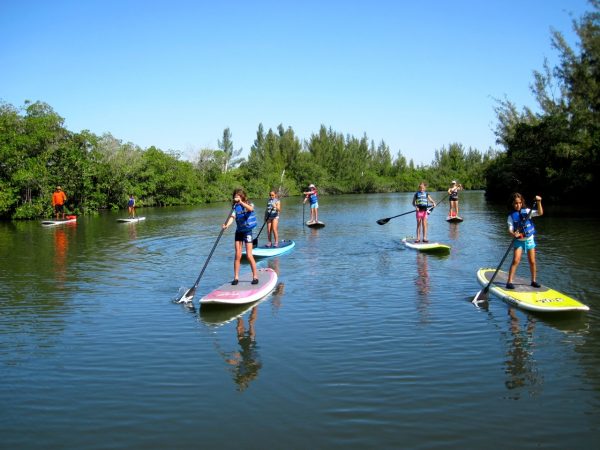
The Barrier Island Center, nestled in the heart of the Archie Carr National Wildlife Refuge in Melbourne Beach, Florida, is bringing back the Eco-Explorers Summer Camps program in 2016. The camps run throughout the month of June and are offered to children ages 9 to 15.

Participants will enjoy unforgettable experiences, from snorkeling to explore life below the ocean surface and kayaking and paddle boarding to observe first-hand the diversity of life on the Indian River Lagoon, to surfing to further connect with the very beach that attracts more nesting sea turtles than virtually any place on Earth.
Camp dates:
 Each session offered will cost $325 and includes transportation, certified aquatic instructors, equipment, t-shirt, a year-long Sea Turtle Conservancy honorary e-membership and a complimentary guided sea turtle walk with preferred reservation! To enroll, complete and fax THIS FORM to 321-952-3207. You may then call 321-723-3556 to make your payment. For more information, visit our website. Enrollment is limited to 13 per week and spots fill up quickly! For questions, please email donnalee@conserveturtles.org We hope to see you there!
Each session offered will cost $325 and includes transportation, certified aquatic instructors, equipment, t-shirt, a year-long Sea Turtle Conservancy honorary e-membership and a complimentary guided sea turtle walk with preferred reservation! To enroll, complete and fax THIS FORM to 321-952-3207. You may then call 321-723-3556 to make your payment. For more information, visit our website. Enrollment is limited to 13 per week and spots fill up quickly! For questions, please email donnalee@conserveturtles.org We hope to see you there!

Join Sea Turtle Conservancy for the second annual Cuba Sea Turtle Expedition! STC is partnering with the Cuba Marine Research and Conservation Program, The Ocean Foundation and Holbrook Travel to offer a Sea Turtle and Cultural Expedition to Cuba from June 25th – July 3rd, 2016.

Participants will visit Havana, the Guanahacabibes Peninsula and Vinales over the course of the expedition. CLICK HERE FOR THE FULL ITINERARY
Participants will have the opportunity to look for turtles coming ashore on the beaches of the Guanahacabibes Peninsula and observe the nesting process.
The group will return to a turtle nesting beach the following day to document any tracks from the previous night.
Hours later, participants will return to the turtle beach where they will have the opportunity to help the researchers measure the turtles and record data.

Participants will also enjoy activities such as a walking tour of Old Havana, a visit to the National Museum of  Natural History, a visit to the Alamar Organoponic Gardens and leisure time.
Natural History, a visit to the Alamar Organoponic Gardens and leisure time.
The beaches of the Guanahacabibes National Park are home to the second largest breeding population of green sea turtles in Cuba with an average of more than 300 nests per season.
2013 was a record year for the park’s beaches with nearly 900 nests recorded!
Through the efforts of University of Havana’s Center for Marine Investigations, an estimated 14,000 hatchlings were saved. You will get to participate directly in this successful Cuban conservation program, with a portion of your trip fees going directly to support this ongoing work.
Watch below to see STCs Cuba expedition from last year:
Cost includes gratuities, Miami/Tampa hotel and donations to the Cuban Society for the Protection of the Environment and Sea Turtle Conservancy.
Cost does not include international airfare estimated at $575 from Miami or Tampa (estimate includes visa fee).
The Sea Turtle Grants Program (STGP), funded by the sale of Florida’s Helping Sea Turtles Survive specialty license plate, recently awarded $311,649.72 to 24 different projects benefiting Florida sea turtles as part of the 2016-2017 grant funding cycle.

Each year, the Sea Turtle Grants Program distributes money to coastal county governments, educational and research institutions and nonprofit groups through a competitive application process. The sea turtle specialty license plate is also the primary source of funding for the Florida Fish and Wildlife Conservation Commission’s Marine Turtle Protection Program.
The following organizations received grants for their approved projects for the 2016-2017 cycle:
The sea turtle plate is the number two overall selling specialty tag in Florida, and the number one environmental specialty plate. By purchasing the sea turtle specialty license plate, Floridians are voluntarily funding important programs to save endangered sea turtles and their habitats.
To learn more about the Sea Turtle Grants Program and the “Helping Sea Turtles Survive” specialty license plate, please visit www.helpingseaturtles.org.